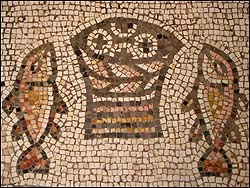Preacher: Jo J. Belser
Location: Church of the Resurrection
Text: Luke 24:36b-48
Day: 3Easter, Year B
“Ingesting Christ Jesus”

A small sample of the THINGS we blessed this Sunday to give away: 16,414 feminine hygiene products given by the Virginia Theological Seminary community, 70 boxes of unsold Girl Scout cookies given by Troop 4737, and 858 gently used children’s books given by a LOT of different people.
I was all set to preach today about being Jesus’ wounded hands and feet. After all, as the epistle of First Peter says, channeling Isaiah:
By [Christ’s] wounds
you have been healed.
We at Church of the Resurrection are so GOOD at being Jesus’ hands and feet. We put into practice the words of the 16th century mystic, Teresa of Avila (which I know you know):
Christ has no body now on earth but yours,
no hands but yours, no feet but yours,
Yours are the eyes through which to look out Christ’s compassion to the world
Yours are the feet with which he is to go about doing good;
Yours are the hands with which he is to bless [us] now.
Yep; I was ready to preach today about putting Christ Jesus’ wounded hands and feet to work out there in our community and in our world. Then I read in Friday’s New York Times about an artist who intends his work to be eaten. Literally. Drawings. Eaten. Dissolved in giant pots of soup. Ingested.
The artist, Eduardo Navarro, has a new exhibition in Manhattan called, “Into ourselves.” Mr. Navarro believes that his artwork will not be destroyed by being eaten. Rather, he rejoices that his art will be forever absorbed INTO the very being of those who eat it, into their cells and possibly, into their minds, to quote the New York Times art critic Meredith Mendelsohn, who (ahem) previewed Mr. Navarro’s show.
Wow. Just as I was dismissing the whole “edible art” concept out of wounded hand (so to speak), I was struck by how we Christ-followers eat Jesus each week and then become him. “We are what we eat,” the old saying declares. And Jean Anthelme Brillat-Savarin, in 1826, in his seven-volume book The Physiology of Taste, said that if we told him what we eat he would tell us what we are. Not to mention the prophet Ezekiel, who 25 centuries before Brillat-Savarin, literally ate scripture to internalize and better speak the Word of God. So, maybe we Christians should understand and affirm the concept of “edible art.”
So much for art; what about life? Real life? Eternal life? How does Christ put his wounded hands and feet to work across time and space and culture to accomplish his monumental divine task?
Our last Bishop, Peter James Lee, attended the Harvard Business Executive’s Leadership Program. He was invited to attend to share how the church transmits corporate vision because, unlike the church, most companies do not survive the loss of their visionary founder. I suspect Bishop Lee did NOT tell them, “You have to get people to eat the founder.” But I’ll bet he shared that we become so synchronized with the mindset of the founder that we function as he would have functioned.
Jesus didn’t instruct his followers in this way, though. He simply said, “This is my Body, given for you,” and “This is my Blood, shed for you.”
With these somewhat cannibalistic thoughts in mind, we can now look anew at today’s gospel lesson when Jesus appeared among his disciples. Apparently, the disciples were sharing a communal meal, hiding out from the authorities, and generally trying to make sense of Jesus’ crucifixion. They also must have been trying to decide what was up with Jesus, so to speak. Had Jesus REALLY appeared to Mary, Peter, Cleopas, and the other disciples? Had Jesus REALLY eaten dinner in Emmaus?

5th century Loaves and Fishes mosaic in the floor of an ancient church and monestary at Tabgha, on the north shore of the Sea of Galilee.
There they were, no doubt a mix of emotions, eating fish. I’ll bet there also was bread, fish and bread. Fish and bread was the menu at many of the very first Eucharist services. Later “eat Jesus” meals did not include fish, merely bread and wine, as at the Last Supper.
Centuries later, the bread became token, ritual. In some denominations, the wine is now reserved for clergy; was this a cost containment measure before becoming simply privilege? We play all sorts of power games by literally withholding all or part of Jesus.
On THIS day, though, the risen Christ asked his disciples, “Do you have any fish?” He’d just had dinner nine miles ago at Cleopas’ house in Emmaus. Could the post-Resurrection life be so very energy consuming?
I know, I know. You want to interpret this eyewitness account as a metaphor. You want to think less concretely, less bodily. You want Christ Jesus to be a disembodied spirit, able to walk through walls. But our lesson insists that the Risen Christ had a physical body and then reminds us that the disciples were witnesses to this reality. They say Jesus used scripture, just like at Emmaus, to explain to them how this was necessary and had been foretold.
When WE meet Jesus face to face he’ll do what he did in today’s lesson: He’ll show us his wounded hands and feet, his ultimate identity card, and probably give us a scripture lesson. And, like in today’s lesson, Jesus will invite us to touch his wounds, then invite us to eat and drink and share his love with our enemies at that great heavenly banquet.
But all of THAT was THEN in the post-Resurrection Upper Room or will be LATER in the great bye-and-bye. What about today, in the hungry here and now?
We faithfully each and drink Christ Jesus each week. When we do, we provide our body and our spirit the fuel they need, the means we need, to act more like Christ. This meal changes us in ways we cannot comprehend.
There is to be a move a-foot <twinkle> to expand the menu of our Jesus-Meal: to serve physically life-sustaining food to people who are literally hungry. As we discovered on Maundy Thursday, this kind of Eucharistic meal is life-sustaining in all the ways we measure life. In our time we seem to have come full circle back to Emmaus, back to that post-Resurrection Upper Room, where we need to ingest Christ Jesus in an expanded Eucharistic meal. The bottom line, though, is that this kind of meal MUST be shared, not withheld just for us or used as an enticement to get physically starving people to participate in our rituals. This isn’t a church growth technique. What is going on is that people are literally starving for what we have: food, physical food as well as the bread and fish, Christ Jesus’ body, of eternal life.

